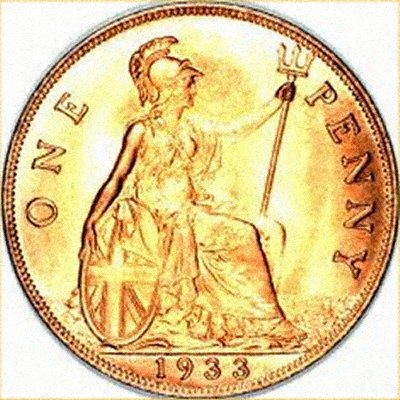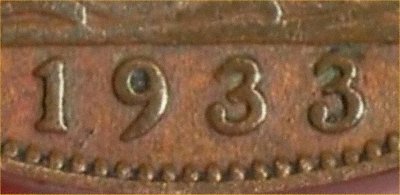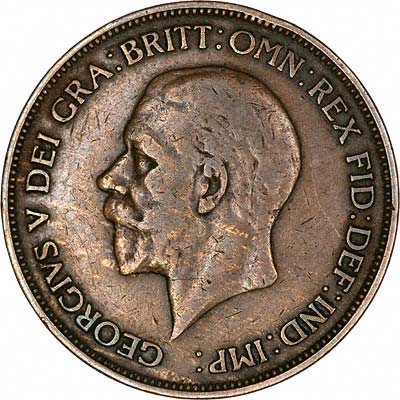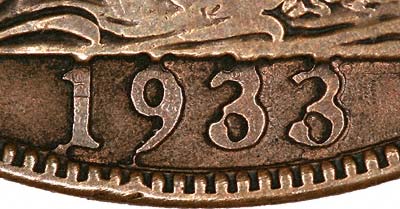| The Very Highest Quality Pennies... |
| 1933 Pennies |
|
 Can This Really be a 1933 Penny? It's One We Made Earlier
|
 Antiques Road Show 1933 Penny
|
 Reverse of Pseudo 1933 Penny
|
 Obverse of Pseudo 1933 Penny
|
 Exergue Area of Pseudo 1933 Penny
|
The 1933 is one of Britain's most famous coin rarities. Many other coins are of equal or greater rarity, but for some reason the 1933 has become the best known of these rarities. We are not sure how the famous reputation of the 1933 penny came about, but we can take a reasonably well-informed guess.
Other Famously Rare British Coins
There are many rare British coins. Some are unique. Rarity in itself does not mean that a coin will become famous for its rarity, indeed most of the rarest British coins are not famous for their rarity. There are usually other reasons for the fame.
Queen Anne farthings are an obvious example. During the reign of Anne, and for a number of years after, they were believed to be very rare and extremely valuable. Copper farthings were a relatively recent innovation, having only been introduced in 1672 during the reign of Charles II. During Anne's reign, none were produced until the last year, 1714. undoubtedly farthings had become popular, but were uneconomical for the mint to produce. There were popular stories at the time of riots because of sightings or losses of Queen Anne farthings. They are actually quite a rare coin, but nowhere near as rare as their reputation would suggest.
1954 pennies are also rare, only one being known to have come onto the market.
Production Problems
The large sized portrait used on coins of George V caused production problems. In fact the problems started, according to a Royal Mint source, in 1887, when the Jubilee Head design was produced. The portraits used on many of the coins since then, were larger than had been previously used. This did not affect pennies until the "Old Head" portrait was introduced in 1893.
Large size Royal portraits continued to be used during the reign of Edward VII and George V.
"Ghosting"
The amount of metal displaced on both of a coin, when it is struck, need to be fairly evenly balanced.
Because the portrait used on early George V coins featured a large head in quite high relief, there was more metal displaced into the obverse than into the reverse. This often resulted in a "shadow" or "ghost" of the head design showing on the reverse, and also a general weakness of the reverse design, particularly noticeable on the pennies.
New bronze alloys were tried during the reign, please see our 1926 modified head penny page.
1933 Pattern Pennies
As in many years, no pennies were needed for circulation, for example, no pennies were minted from 1923 to 1925, so none were produced or issued for circulation.
In 1933, the Royal Mint were still trying to solve the problems of ghosting, and they continued to produce a number of experimental designs. A small number of these were tested by striking coins, pennies, from the experimental die designs. As these were not intended for circulation, they were never issued. Some of these are "uniface", that is they are single-sided, the opposite side remaining blank. The writer had personally seen and handled two such coins, at the British Museum Coin Room, about 20 years ago.
This type of coin, not intended for circulation, is usually known as a "pattern" coin.
Only about six pieces were produced in total, two belong to the British Museum collection, others are in the Royal Mint's collection.
Urban Myths & Rumours
The exact reasons why 1933 pennies are well known as rarities will probably never be known, however it is likely that a small content of fact alloyed with a large amount of misinformation is the cause.
There are parallels in the case of the Queen Anne farthing, and also recently in the £2 Necklace Rumour.
People like a good entertaining story, and are quite happy to believe it, embellish it, and re-broadcast it. the media helps this process along, often through inaccurate reporting, preferring not to let truth or accuracy stand in the way of a good yarn. Readers like to think they can make money for nothing, so are prepared to believe what the media, or others, tell them.
Certainly 1933 pennies are a valuable rarity. None are available to the public or to collectors, none are ever likely to be offered for sale. It is extremely unlikely that there are any "undiscovered" ones which have somehow slipped out into circulation, if so they would have been discovered long ago.
Stolen
Three of the 1933 pennies were known to have been placed under foundation stones of buildings. One is a building belonging to The University of London in Bloomsbury, two others were under churches in the Ripon diocese in Yorkshire. In September 1970, the Church of St. Cross at Middleton near Leeds was damaged by thieves who managed to remove and steal the 1933 penny buried under its cornerstone. As a precaution, the other church removed its coin, and sold it by auction at Sotheby's on the 24th November 1972.
1933 Penny Sightings
Over the years we have been coin dealers we have had many people tell us about 1933 pennies they have found. Most of these turn out to be Australian, British West Africa, Jersey, or Irish pennies, and their owners, usually victims of their own wishful thinking, omit to mention the fact that they are not British pennies. Needless to say, none of these are rare or extremely valuable.
At least once each year, we receive a phone call from someone who has just found one, and when we suggest that they are probably misreading the date, assure us that they are not, and state their intention to visit us without delay to show us and maybe sell it. So far none us these people have ever arrived. Perhaps a number of the people who go missing every year are victims of a curse on the owner of 1933 pennies!
1933 Halfpennies
It should go without saying, that just because 1933 pennies are rare, the same does not apply to halfpennies, or any other coin denomination of 1933, yet people still get strangely excited by finding one.
Forgeries
Although we have never seen any direct forgeries of 1933 pennies, we have seen a few pennies where some skilled craftsman has carefully altered the date of another penny, usually 1935, to read 1933. Another method of faking a rare date coin is to remove a numeral from one coin, by carefully slicing it off, grind away from another coin the numeral to be altered, and transplanting the sliced date onto the space created. In this way, one "rare" date can be created from two common ones.
Worth Looking For?
Our advice is "don't even bother to look". If someone ever did find a 1933 penny in amongst a number of other pennies, it would be interesting to compare the amount of money it would raise against the number of man hours which have been spent looking for it. We believe it would work out to be less than one millionth of the national minimum wage. Take our advice, don't waste your time looking!
Looking for the Loch Ness monster is likely to be more productive, and you might catch some fish at the same time.
Made of Gold?
Another stupid rumour we hear from time to time is that some gold accidentally got mixed into the alloy which was used to make 1933 pennies. This is totally untrue and unfounded.
The origin of the story may lie in the experimental alloys which were used to cure the "ghosting" problems, or because of slightly uneven alloying in some George V pennies. Once again silly stories such as this tend to spread largely because people want to believe in the chance of getting something for nothing.
None Issued - Why Not?
Another question which we get asked almost daily about various dates of coins, including the 1933 penny, is "Why were none issued?"
The simple answer why no coin of a particular denomination and date was issued is usually because none were needed. It would be more sensible to ask why should any have been made. If there are enough pennies, pounds or any other coins in circulation at the time, then the mint will not waste its time making any.
Antiques Road Show
We noticed a coin being shown on the Antiques Road Show on Sunday 25th July 2004, and just caught the tail end of it. The A.R.S. (terrible acronym!) expert wasn't sure whether it was genuine, but thought about £30,000 was about right if genuine, but said that about one fake turned up every year. From the very quick shot we saw of the coin, it looked like a genuine penny, but with the second 3 of the date transplanted from another coin. This was only from noticing that there was a dark area near the date around the top right of the second 3. Obviously we would have needed a closer examination to be able to form a conclusive opinion. It surprises us, though, that the expert had not apparently examined the coin under magnification. We use a number of different magnifications up to x10, but find that a high definition photograph (6 megapixels), can be even better, provided the lighting is optimal.
Thanks to the BBC and Bright Ideas for providing us with an image of the Roadshow coin. We have rotated and cropped it, and show the its date area to the right. It is not easy to see clear and undisputable signs of alteration, but the final "3" of the date does show some peculiarities which we think are sufficient to conclude that it has been manufactured, and almost certainly from two other pennies in the 1930 to 1936 date range.
Altered Identity
In March 2008, we were contacted by a person who believed they were in possession of a 1933 penny. As usual we said we would be interested to see it. Three photographs of this pseudo coin are shown on the right. On this coin, it is very obvious that the date has been altered, but it is surprising because the whole of the date area appears to have been tampered with. There are what appear to be flashes where there should be a gap in the lower section of both 3s. There are also what look rather like casting sprues at the between the tops of all the coins and the ground line above them, and also from the bottom of the 1 and 9, joining them to an arc inside the toothed border. This arc, or inner circle, is not present on normal pennies of this period. From this it appear likely that the whole date area has been manufactured, then transplanted onto the original coin, or that the date area has been removed, probably ground down, and then new date numerals, probably sourced by cannibalising a few other pennies from the same period, by soldering or brazing. The second 3 of the date also shows some doubling to its right.
An interesting, but unconvincing, attempt to create an apparent 1933 penny.
eBay Fake, Fraudster & Copyright Thief
Nearly got £500 for a fake, and stole our photographs to do so.
Book Recommendation
English Copper, Tin and Bronze Coins in the British Museum 1558 - 1958
* An excellent book, "English Copper, Tin and Bronze Coins in the British Museum 1558 - 1958", by C. Wilson Peck, published by the Trustees of the British Museum in 1964, is useful for information on this and other pennies. It was originally priced at £5.12s.6d (=£5.625), but is now out of print. I have been told that second-hand copies change hands at about £100 in good condition.
If you want to find the value of a coin you own, please take a look at our page I've Found An Old Coin, What's It Worth?
If you have an enquiry about any of our pennies we'd be happy to try to answer you, but do please ensure you look at our other information pages before asking a generalised question.
| ...at the Lowest Possible Price |
|
32 - 36 Harrowside, Blackpool, Lancashire, FY4 1RJ, England. Telephone (44) - (0) 1253 - 343081 ; Fax 408058; E-mail: The URL for our main page is: https://24carat.co.uk | Chard(1964) Ltd |